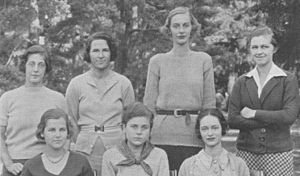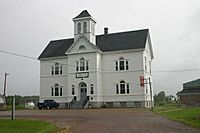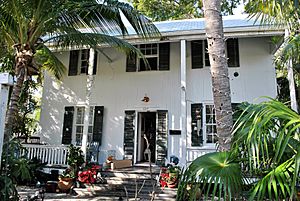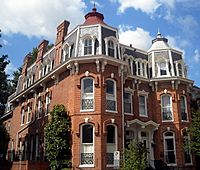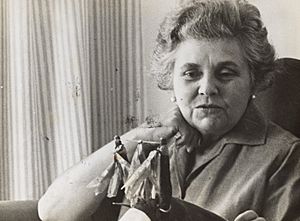Elizabeth Bishop facts for kids
Quick facts for kids
Elizabeth Bishop
|
|
|---|---|

Bishop in 1934 as a senior at Vassar
|
|
| Born | February 8, 1911 Worcester, Massachusetts, U.S. |
| Died | October 6, 1979 (aged 68) Boston, Massachusetts, U.S. |
| Occupation | Poet |
| Notable awards |
|
| Partner | Lota de Macedo Soares (1952–1967) Alice Methfessel (1971–1979) |
| Signature | |
Elizabeth Bishop (February 8, 1911 – October 6, 1979) was an American poet and short-story writer. She won many important awards for her writing. These include the Pulitzer Prize for Poetry in 1956. She also won the National Book Award in 1970. In 1976, she received the Neustadt International Prize for Literature.
Contents
Early Life and Education
Elizabeth Bishop was born in Worcester, Massachusetts. Her father died when she was only eight months old. Her mother became very ill and had to go to a hospital in 1916. This meant Elizabeth was like an orphan when she was very young.
She went to live with her grandparents on a farm in Great Village, Nova Scotia, Canada. She wrote about this time in her stories. Later, her father's family took her to live in Worcester, Massachusetts. She was not happy there and felt lonely. She also developed asthma, a breathing problem, which she had for the rest of her life.
In 1918, her grandparents sent her to live with her aunt Maude in Revere, Massachusetts. Her aunt introduced her to classic writers like Alfred, Lord Tennyson.
School Days and First Poems
Elizabeth was often sick as a child. She did not have much formal schooling at first. She went to Saugus High School for a year. Then she attended the Walnut Hill School where she studied music. Her first poems were published in a student magazine there.
In 1929, she went to Vassar College in New York. She planned to study music. But she changed to English because she was afraid to perform. She published her work in a magazine during her senior year. In 1933, she helped start a literary magazine called Con Spirito. She graduated from Vassar in 1934.
Literary Influences and Friendships
Elizabeth Bishop was greatly influenced by other poets. These connections helped her grow as a writer.
Marianne Moore's Guidance
In 1934, Bishop met the poet Marianne Moore. Moore became very interested in Bishop's writing. She even convinced Bishop not to go to medical school. Moore helped Bishop publish some of her early poems. Their friendship lasted for many years. They wrote many letters to each other.
Friendship with Robert Lowell
Bishop also became good friends with the poet Robert Lowell in 1947. They often wrote letters to each other. Their friendship lasted until Lowell's death in 1977. They also influenced each other's poetry. Lowell said Bishop's poem "The Armadillo" inspired his poem "Skunk Hour." Bishop wrote a poem called "North Haven" in memory of Lowell.
Travels and Life Abroad
Elizabeth Bishop had money from her father's family. This allowed her to travel a lot without needing a job. She wrote about her travels in poems like "Questions of Travel."
Living in Key West and Washington, D.C.
In the mid-1930s, she lived in France for several years. In 1938, she bought a house in Key West, Florida. She met Pauline Pfeiffer Hemingway there. From 1949 to 1950, she worked as a poetry consultant for the Library of Congress in Washington, D.C..
Years in Brazil
In 1951, Bishop received a travel grant. She planned to travel around South America. She arrived in Santos, Brazil, and planned to stay for two weeks. But she ended up staying for 15 years! She lived in Petrópolis with Lota de Macedo Soares, an architect.
While in Brazil, Bishop became interested in Brazilian literature. She translated poems by Brazilian poets like João Cabral de Melo Neto. After Soares passed away in 1967, Bishop spent more time in the United States.
Published Works and Major Awards
Elizabeth Bishop did not publish many books of poetry. But the ones she did publish were very important.
Her first book, North & South, came out in 1946. It won the Houghton Mifflin Prize for poetry. This book included famous poems like "The Fish."
Nine years later, in 1955, she published Poems: North & South—A Cold Spring. This book included her first book plus 18 new poems. She won the Pulitzer Prize for this book in 1956.
Her next book, Questions of Travel, was published in 1965. This book showed how living in Brazil influenced her writing. It included poems about Brazil. It also had poems about her home country, like "In the Village."
In 1969, she published The Complete Poems. This book won a National Book Award. Her last book of poems, Geography III (1977), included well-known poems like "In the Waiting Room" and "One Art." This book helped her become the first American and first woman to win the Neustadt International Prize for Literature.
After she passed away, more of her works were published. These included The Complete Poems, 1927–1979 in 1983.
Literary Style
Elizabeth Bishop had a unique writing style. Unlike some poets who wrote a lot about their personal lives, Bishop kept her poetry more distant. She focused on detailed descriptions and an objective point of view. She was careful when writing about her own life. For example, "In the Village," a story about her childhood, is written as if it happened to someone else.
Key Poems
- "In the Waiting Room" (1976): This poem explores how a seven-year-old girl tries to understand her own identity. It is set in Worcester, Massachusetts, during World War I.
- "First Death in Nova Scotia" (1965): This poem describes Bishop's first experience with death. It tells the story from a child's point of view. The poem shows how even young children can sense the sadness of death.
- "Sestina" (1965): This poem is about Bishop living with relatives after her father died and her mother became ill. It shows her sadness about not seeing her mother again. Bishop was very skilled at writing in the "sestina" style. This is an old poetry form that uses repeating words at the end of lines.
Later Life and Legacy
In the 1970s, Bishop started teaching at universities. She taught at the University of Washington and Harvard University. She also taught at New York University and the Massachusetts Institute of Technology.
In 1971, she started a relationship with Alice Methfessel. Alice later became the person in charge of Bishop's writings after her death.
Elizabeth Bishop passed away on October 6, 1979, in Boston. She is buried in Hope Cemetery (Worcester, Massachusetts). Her chosen epitaph, or words on her tombstone, are from her poem "The Bight": "All the untidy activity continues, / awful but cheerful."
After her death, the Elizabeth Bishop House was created in Great Village, Nova Scotia. It is a place for artists to stay and work. Her writings and letters are kept at Vassar College Library and other research libraries.
Awards and Honors
- 1945: Houghton Mifflin Poetry Prize Fellowship
- 1947: Guggenheim Fellowship
- 1949: Consultant in Poetry at the Library of Congress
- 1950: American Academy of Arts and Letters Award
- 1951: Lucy Martin Donelly Fellowship (from Bryn Mawr College)
- 1953: Shelley Memorial Award
- 1954: Elected to the National Institute of Arts and Letters
- 1956: Pulitzer Prize for Poetry
- 1960: Chapelbrook Foundation Award
- 1964: Academy of American Poets Fellowship
- 1968: Fellow of the American Academy of Arts and Sciences
- 1969: The Order of Rio Branco (from the Brazilian government)
- 1970: National Book Award for Poetry
- 1974: Harriet Monroe Poetry Award
- 1976: Neustadt International Prize
- 1976: Elected to the American Academy of Arts and Letters
- 1977: National Book Critics Circle Award
- 1978: Guggenheim Fellowship
- 2010: Elected to the New York Writers Hall of Fame
Works
- Poetry collections
- North & South (1946)
- Poems: North & South. A Cold Spring (1955) —winner of the Pulitzer Prize
- Questions of Travel (1965)
- The Complete Poems (1969) —winner of the National Book Award
- Geography III (1976)
- The Complete Poems: 1927–1979 (1983)
- Edgar Allan Poe & The Juke-Box: Uncollected Poems, Drafts, and Fragments (2006)
- Other works
- The Diary of Helena Morley (translation, 1957)
- The Ballad of the Burglar of Babylon (1968)
- An Anthology of Twentieth Century Brazilian Poetry (edited, 1972)
- The Collected Prose (1984)
- One Art: Letters, (selected letters, 1994)
- Exchanging Hats: Elizabeth Bishop Paintings, (paintings, 1996)
- Words in Air: The Complete Correspondence Between Elizabeth Bishop and Robert Lowell (letters, 2008)
See also
 In Spanish: Elizabeth Bishop para niños
In Spanish: Elizabeth Bishop para niños


